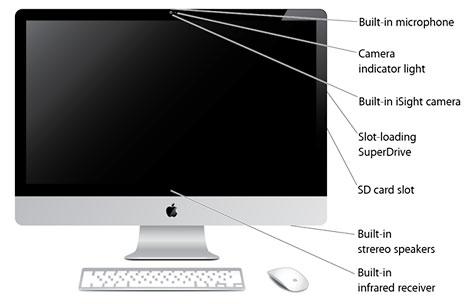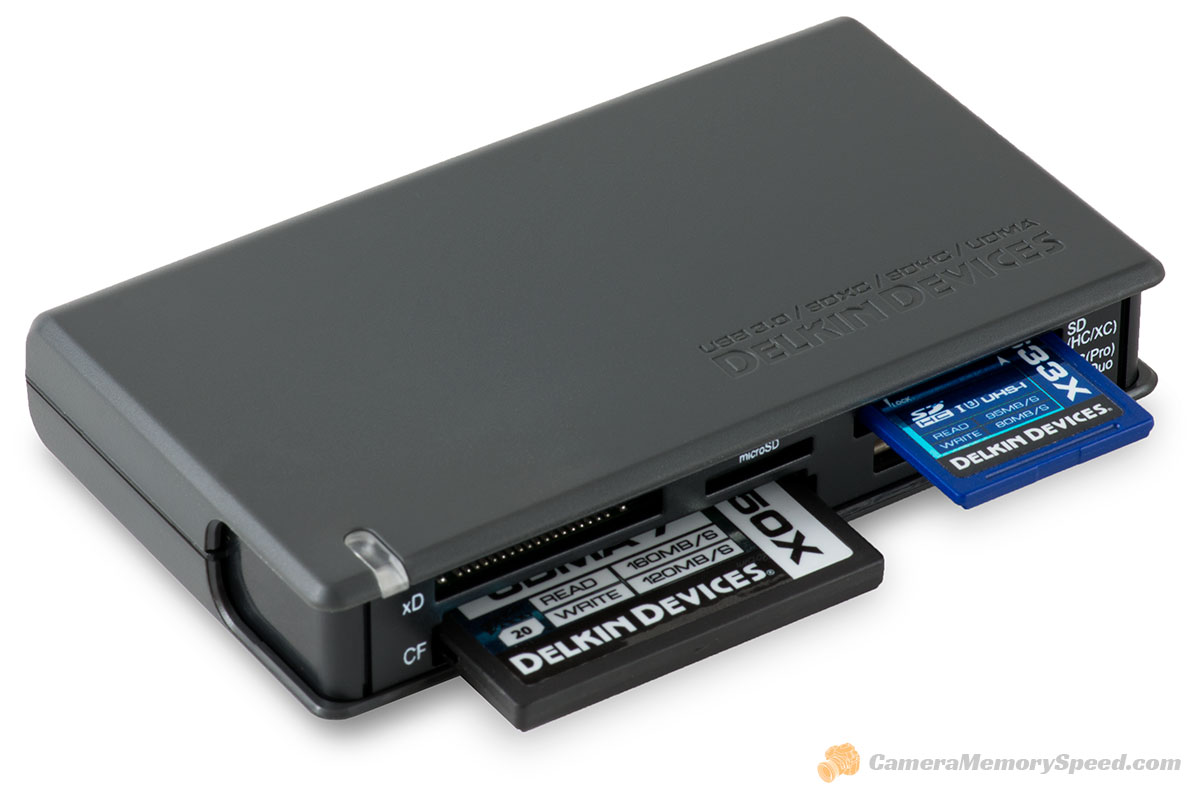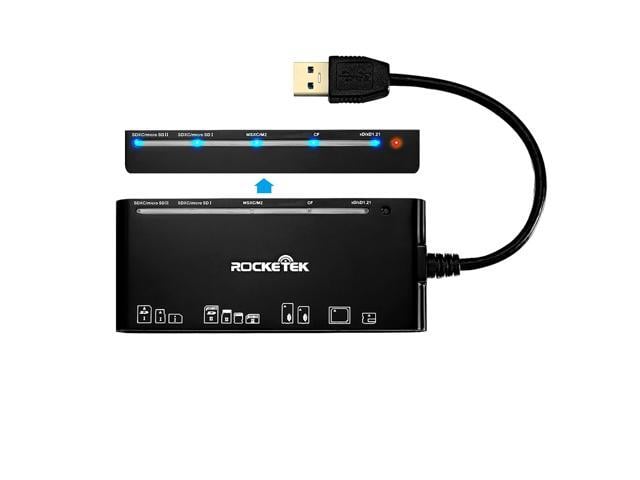8 Slot Memory Card Reader

Universal Silicon Power Multi-Slot 8-in-1 Flash Memory Card Adapter / Reader / Writer SP8R-2 is a 8 in 1 Card Reader / Writer, a small USB device designed for fast easy data exchange storage media. The Memory Card Adapter Reader supports Compact Flash Cards (CF), IBM Microdrives, Smart Media Cards (SMC), Memory Stick (MS) and MemorySticks Pro. This is an excellently designed and built USB 3.0 multi memory card reader. Very well packaged, too. It has 2 SD card slots so you can actually transfer pictures and data directly between 2 SD at the same time. Other reviewers note the pins in the CD card slot are thin and I plan to be extremely careful with them.
CFexpress is a standard for removable media cards proposed by the CompactFlash Association (CFA). The standard uses PCIe 3.0 interface with 1 to 4 lanes where 1 GB/s data can be provided per lane. NVM Express is also supported to provide low overhead and latency. There are multiple form factors that feature different PCIe lane counts.[1] One of the goals is to unify the ecosystem of removable storage by being compatible with standards already widely adopted, such as PCIe and NVMe. There already is a wide range of controllers, software and devices that uses these standards, accelerating adoption.
SD memory Card Reader/ Slot is not working on Windows 10 I have installed the new windows 10 in my PC, before this i had windows 7 home premium. I have a memory card adapter in which i used to slid my micro SD card and was able to access it when i had windows 7, but when i upgraded to windows 10 and inserted the memory card reader in the slot. Molex offers compact memory card sockets with a height of no more than 1.28mm, saving PCB space. As products become smaller, a minor external shock could cause short-circuit or misalignment. The hinge feature keeps the card stable, protecting it from external shocks and/vibrations. Memory card reader prices. Low-end memory card readers for $5 to $10 typically accommodate one card format and often plug directly into USB 2.0 ports. Mid-range memory card readers for $10 to $15 have anywhere from two to six ports for a variety of card.
History[edit]
On 7 September 2016, the CompactFlash Association announced CFexpress.[1] The specification would be based on the PCI Express interface and NVM Express protocol.
On 18 April 2017 the CompactFlash Association published the CFexpress 1.0 specification.[2] Version 1.0 will use the XQD form-factor (38.5 mm × 29.8 mm × 3.8 mm) with two PCIe 3.0 lanes for speeds up to 2 GB/s. NVMe 1.2 is used for low-latency access, low overhead and highly parallel access.
On 13 June 2017, Delkin introduced the first CFexpress cards based on the CFexpress 1.0 specification.[3] In February 2018, they released benchmarks, with sample units introduced in the second quarter of 2018, and production scheduled for the third quarter.[needs update]
The CFexpress 2.0 standard was announced on 28 February 2019. It features two new card formats ('type A', one lane, more compact and 'type C', four lanes, bigger and thicker, up to 4 GB/s), with the existing cards designated as 'type B'. The NVM Express protocol was upgraded to 1.3.[4]
In the future, there are plans to increase the speed further by adopting PCIe 4.0.
Comparison[edit]
| Standard | SD | UFS Card | CFast | XQD | CFexpress | ||||||||
|---|---|---|---|---|---|---|---|---|---|---|---|---|---|
| Version | 3.0 | 4.0 | 6.0 | 7.0[5] | 8.0 | 1.0 | 2.0 | 1.0 | 2.0 | 1.0 | 2.0 | 1.0 | 2.0 |
| Launched | 2010 Q2 | 2011 Q1 | 2017 Q1 | 2018 Q2 | 2020 Q2 | 2016 Q2 | 2018 Q4 | 2008 Q3 | 2012 Q3 | 2011 Q4 | 2014 Q1 | 2017 Q2 | 2019 Q1 |
| Bus | UHS-I | UHS-II | UHS-III | PCIe 3.0 x1 | PCIe 4.0 x2 | UFS 2.0 | UFS 3.0 | SATA-300 | SATA-600 | PCIe 2.0 x1 | PCIe 2.0 x2 | PCIe 3.0 x2 | PCIe 3.0 x4 |
| Speed (full-duplex) | 104 MB/s | 312 MB/s | 624 MB/s | 985 MB/s | 3938 MB/s | 600 MB/s | 1.2 GB/s | 300 MB/s | 600 MB/s | 500 MB/s | 1.0 GB/s | 1.97 GB/s | 1.0 GB/s 2.0 GB/s 4.0 GB/s |
Form Factors[edit]
CFexpress supports the following card sizes.[6] The second column lists the oldest CFexpress versionthat includes the form factor.
| Form Factor | CFexpress version | Dimensions (millimeters) | PCIe Lanes |
|---|---|---|---|
| A | 2.0 | 20 x 28 x 2.8mm | 1 |
| B | 1.0 | 38.5 x 29.8 x 3.8mm | 2 |
| C | 2.0 | 54 x 74 x 4.8mm | 4 |
The larger form factors have more electrical contacts, allowing more PCIe lanes to be used.Form factor B has the same size and contacts as an XQD card, allowing a single card slot to accept both XQD and CFexpress-B cards.[7]
Compatible devices[edit]
Cards[edit]
Delkin[edit]
On 13 June 2017, Delkin introduced the first CFexpress cards, which were on the CFexpress 1.0 specification.[3] The cards have a XQD form factor and use two PCIe 3.0 lanes. They come in 32 GB, 64 GB, 128 GB and 256 GB capacities.
More details on Delkin's CFexpress cards were revealed in February 2018.[8][9] The cards should be able to be read from and written to with respectively up to 1.6 GB/s and up to 1.0 GB/s benchmarked with CrystalDiskMark 5.2.1. Sample units will be available in Q2 2018 and production is scheduled for Q3 2018.
Delkin's 512 GB Power CFexpress Type B card was reviewed along with several others in the early fall of 2020. Camnostic.com rated it the recommended buy due to generally doing well in its tests, but also because it was the cheaper of the alternatives. The article mentioned a firmware upgrade to address compatibility with the Canon EOS R5 camera in late September 2020.[10]
ProGrade Digital[edit]
ProGrade Digital announced it would begin production and sale of CFexpress cards in 2018 with the Type-B form-factor (the same as XQD).[11]The 1 TB CFexpress card that ProGrade Digital showed at the Spring NAB show in 2018 demonstrated 1,400 Mbit/s (Mbyte/sec?)read speed and over 700 Mbit/s (Mbyte/sec?)burst write speed. This demonstration was performed using a Thunderbolt 3 CFexpress/XQD reader on a[12] MacBook Pro computer.
Apacer[edit]
On 11 December 2018, Apacer announced its first CFexpress card,[13] the PV130-CFX.[14]
Wise Advanced[edit]

On 7 April 2019, Wise Advanced announced it was producing CFexpress cards with 512GB, 256GB, and 128GB capacities, as well as a CFexpress Card Reader, all using CFexpress Type B.[15]
Readers[edit]

BLACKJET TX-1CXQ[16]
Parts[edit]
On October 2, 2017, Rego Electronics announced CFexpress host connectors and card cardkits, parts that manufacturers can use for their CFexpress devices and cards.[17][18][19]
Client devices[edit]
As of October 2017, there were no CFexpress client devices released. However, in late October 2017 a Lexar employee stated to Nikon Rumors:
CFExpress is essentially the next revision of XQD, and there should be full backward compatibility with XQD, and that getting D4/D5/500/D850’s to work with CFE cards should be a simple software patch.[20]
On 23 August 2018, Nikon announced their new mirrorless cameras, the Z6 and Z7. At launch they only supported XQD cards, but a later firmware update enabled support for CFexpress.[21][22] On 13 February 2019, Nikon further confirmed that CFexpress support via a firmware update will also be coming to the D5, D850 and D500.[23] On 16 December 2019, Nikon released firmware version 2.20 for the Z6 and Z7, adding support for CFExpress.[24]
On 28 August 2018, Phase One announced the XF IQ4 camera system (three bodies). Like the Nikon cameras, future support for CFexpress was added in a later firmware update.[25]
On 24 October 2019, Canon announced the development of the EOS-1D X Mark III with dual CFexpress slots.[26] The camera was officially released on 6 January 2020, with availability set for February.[27]
On 12 February 2020, Nikon announced the Nikon D6, which uses dual CFexpress slots.[28]
On 20 April 2020, Canon announced that the EOS R5, a hybrid mirrorless camera, will support CFexpress and SD UHS-II.[29]
On 28 July 2020, Sony announced the α7S III, a mirrorless camera that will support dual CFexpress and SD cards.[30]
See also[edit]
References[edit]
- ^ ab'CFA 5.1 Press Release'(PDF).
- ^'CFexpress 1.0 Press Release'(PDF).
- ^ ab'Industrial CFexpress 1.0 and Industrial CFX 1.0 Cards'. Delkin Industrial. Retrieved 2017-06-29.
- ^CFA announces CFexpress 2.0 specification
- ^Shilov, Anton. 'SD Association Announces SD 7.0 Spec & SD Express Interface: PCIe + NVMe, Up to 985 MB/s'. AnandTech.
- ^'CFexpress 2.0 Specification Introduces two New Form Factors'. Retrieved 2020-08-23.
- ^'CFexpress: The Next Serious Media Format'. Retrieved 2020-08-23.
- ^'Industrial CFexpress 1.0 and Industrial CFX 1.0 Cards'. Delkin Industrial. Retrieved 2018-02-24.
- ^'Delkin Ships More Samples of Newest Form Factor CFexpress to OEMs'. Retrieved 2018-02-24.
- ^'CFEXPRESS MEMORY CARD REAL-WORLD CANON EOS R5 PERFORMANCE'. Retrieved 2020-10-18.
- ^'Confirmed: ProGrade Digital will NOT make XQD cards, is betting on CFexpress instead'. DPReview. Retrieved 2018-03-05.
- ^prograde digital incorporated
- ^Inc, Apacer Technology. 'A New Force Driving High-Speed SSD – Apacer's Latest CFexpress Card - News & Events - Apacer for Industrial - The most reliable storage and memory'. industrial.apacer.com. Retrieved 2019-01-08.
- ^Inc, Apacer Technology. 'PV130-CFX - CFexpress - PCIe - SSD - Apacer for Industrial - The most reliable storage and memory'. industrial.apacer.com. Retrieved 2019-01-08.
- ^'Wise Advanced Introduces CFexpress Type B Memory Card and Card Reader'. www.wise-advanced.com. Retrieved 2019-04-11.
- ^https://www.atechflash.com/blackjet-tx1cxq
- ^'REGO ELECTRONICS News - CFexpress Card Connectors & Card kits'. www.rego.com.tw. Retrieved 2017-10-09.
- ^'REGO ELECTRONICS Card Host Connectors'. www.rego.com.tw. Retrieved 2017-10-09.
- ^'REGO ELECTRONICS CFexpress Card Cardkits'. www.rego.com.tw. Retrieved 2017-10-09.
- ^'More info on Lexar, XQD and CFExpress memory cards compatibility, Hoodman rumored to start making XQD cards Nikon Rumors'. nikonrumors.com. Retrieved 2017-11-08.
- ^'Nikon announced the development of new firmware for the Z6, Z7, D5, D850 and D500 cameras'. Nikon Rumors. 2019-02-13.
- ^'Nikon to add Eye AF, Raw video and CFexpress support to Z-series'. DPReview. Retrieved 2019-01-08.
- ^'Nikon Z6/Z7 firmware update 2.0 with eye AF officially released'. Nikon Rumors. 2019-05-15.
- ^'Nikon Z Series Evolves To Become Even More Powerful: Firmware Ver. 2.20 Released, Adds Support For CFexpress Memory Cards; Paid Service To Install RAW Video Output Function Also Begins'. 2019-12-23. Archived from the original on 2019-12-23. Retrieved 2019-12-23.
- ^'XF IQ4 150MP Camera System'. phaseone.com. 2018-08-28.
- ^'Canon announces development of the new EOS-1D X Mark III flagship DSLR camera'. global.canon.com. 2019-10-24.
- ^'A Masterpiece In Engineering And Design: Canon Announces The EOS-1D X Mark III Camera' (Press release). Canon U.S.A., Inc. 2020-01-06. Retrieved 2020-01-29.
- ^https://www.nikon.com/news/2020/0212_dslr_01.htm
- ^'The Secret Is Out: Canon Officially Announces The Canon EOS R5 and R6, The Company's Most Advanced Full-Frame Mirrorless Cameras Ever' (Press release). Canon U.S.A. Inc. July 9, 2020. Retrieved July 9, 2020.
- ^'Sony Announces The α7S III: Redefining The Possibilities For Creatives'. Retrieved 28 July 2020.
Summary :
You know that you can’t connect the SD card to your computer directly. Thus, to access to the files on the SD card using the computer, you need an SD card reader. Now, you can read this post to learn some useful information about SD card reader.
Quick Navigation :
What Is SD Card Reader
As a new type of storage device based on semiconductor flash memory, SD (Secure Digital) memory card is produced to increase the capacity of digital devices. And it is favored and used by a lot of people due to its excellent characteristics of small size, fast data transfer and hot swap.
At present, SD card is the most common memory card on the market. It is now widely used in digital camera, DV, MP4, MP3, PDA and smart phone.
Well, SD card reader is a kind of device used specially for reading SD card. It's an external device with corresponding SD card slot and USB interface. Besides, it supports reading & writing data and allows the access to SD card files.
Actually, a card reader is specially designed to share information on SD card conveniently.
Usually, an SD card reader is not very heavy and the size of it is small. Some of the card readers are even close to that of common USB flash drives. Thus, it's easy to carry around. What's more, the function of card reader with SD card inserted is basically the same with that of USB flash drive.
For a computer, the card reader is similar to a USB floppy drive; the tiny difference lies in - what the card reader reads is a variety of flash memory cards while USB floppy drive only reads floppy disk.
8 Slot Memory Card Reader Card Reader

Using skills: insert SD card into the corresponding slot on one end of card reader, and then connect the USB interface on the other end of card reader to computer. Only when the SD card is properly inserted into card reader and the card reader USB interface is properly connected to computer, can we succeed in accessing SD card and reading/writing data correspondingly.
How to Use SD Card Reader
Step 1: select Recover from SD-Card.
Step 2: insert SD card.
Step 3: select the inserted SD card to scan.

Memory Card Reader Adapter
Step 4: analyze the SD card.
Step 5: check files to recover when scan is completed.
What If We Don't Have a Card Reader
If you have no card reader to read SD card data on computer, you may as well consider buying one at Amazon (for reference only):
http://www.amazon.com/s/ref=nb_sb_ss_c_0_10?url=search-alias%3Daps&field-keywords=sd+card+reader&sprefix=SD+CARD+RE%2Caps%2C549&rh=i%3Aaps%2Ck%3Asd+card+reader.
SD Card Reader FAQ
Most new flat panel TVs have an SD card reader. You can go to see the side or the back of your TV to check whether there is an SD card reader. You can also read the device list of the TV to check whether there is such an SD card reader. If there is, you can directly insert the SD card to the card reader and use the card on TV.